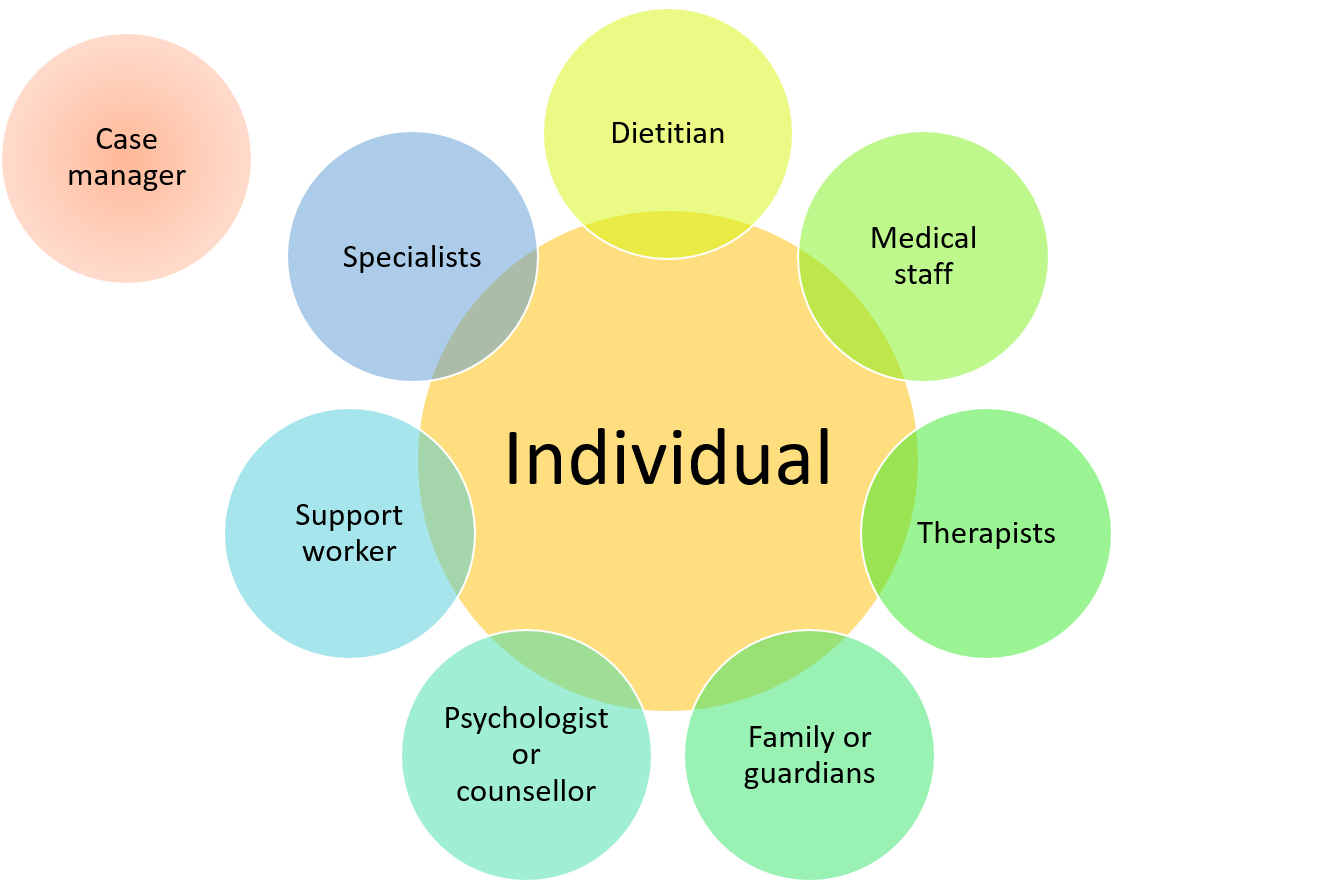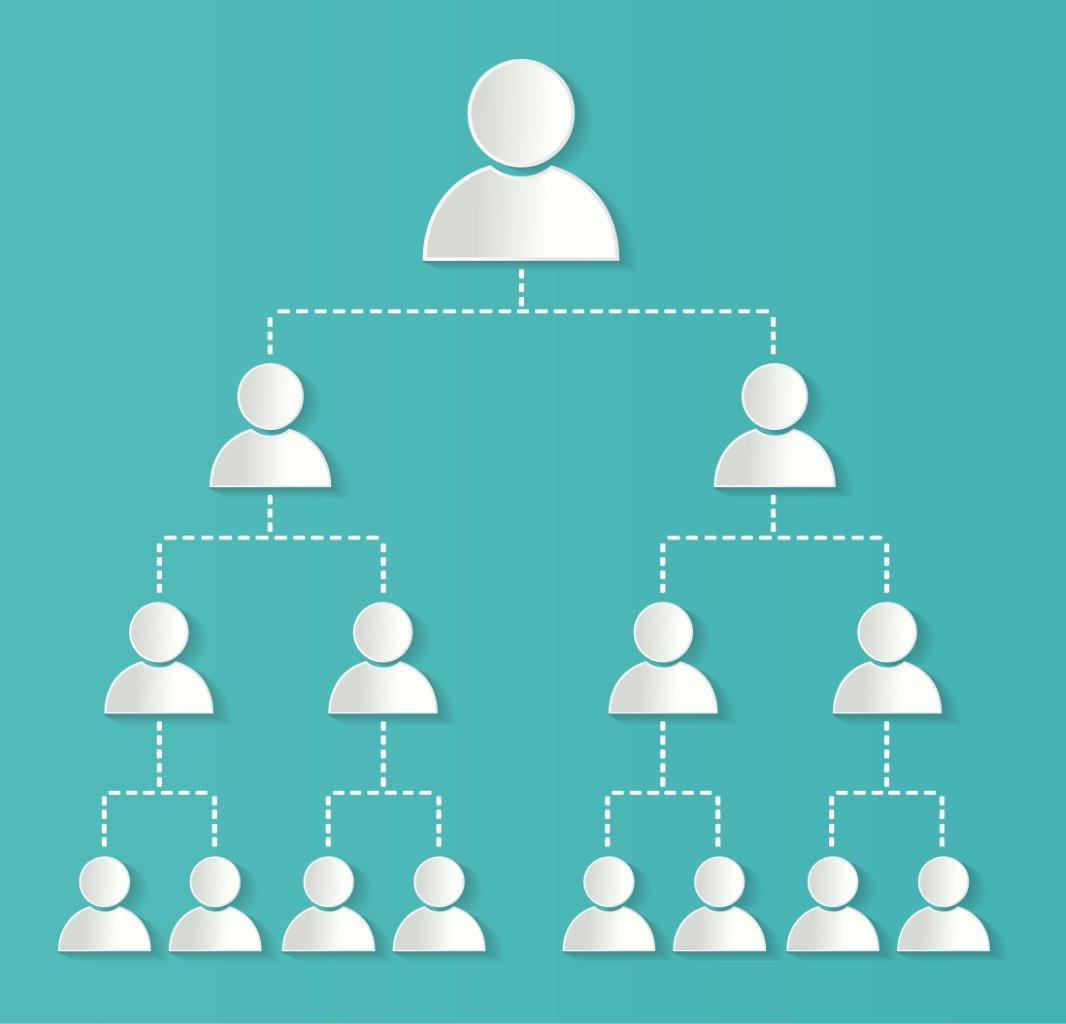2. Collaborate with colleagues
| Site: | StudentWeb |
| Course: | 2025 Communicate and work in health or community services (VDSS_CHCCOM005) |
| Book: | 2. Collaborate with colleagues |
| Printed by: | Guest user |
| Date: | Friday, 15 August 2025, 9:19 PM |
Description

Table of contents
- 1. ACTIVITY
- 2. Collaborate
- 3. Communicate with colleagues and other services
- 4. Multi-disciplinary teams (MDTs)
- 5. Community services sector
- 6. Lines of communication
- 7. Industry terminology
- 8. Approach types for interacting with other agencies
- 9. Structure and function of Australia’s health system
- 10. Interrelationships between the health and community service system
- 11. Funding environments
- 12. Learning activity
1. ACTIVITY
Watch the video below
ACTIVITY:
Your teacher will give you a piece of paper and some origami instructions.
Follow the instructions and compare your end product.
Were the instructions clear? Does everyone's origami look the same?
Reflect on what happened
2. Collaborate
Consider the term, 'collaborate with colleagues'.Collaborate or collaboration is the process of two or more people or organisations working together to complete a task or achieve a goal.
Synonyms, or words that are similar to collaborate include:
- cooperate
- join forces
- team up
- work together
When collaborating with colleagues in the workplace, it’s essential to ensure that everyone is on the same page regarding instructions and timelines. Effective collaboration involves:
- Clarifying and agreeing on workplace instructions: Make sure you fully understand the tasks assigned and confirm any details with your colleagues.
- Agreeing to, and adhering to, timeframes: Listen carefully to instructions, clarify any uncertainties, and agree on realistic deadlines for completing tasks. Sticking to these agreed timeframes is crucial for maintaining efficiency and meeting expectations for clinical and non-clinical tasks.
- Following requests within the organisation and external services: Ensure that you respect and follow requests whether they come from within your team or other departments and services. This includes following up on requests in a timely manner.
- Adhering to standard protocols: Follow established organisational guidelines, particularly when working with different teams, supervisors, and lines of authority, to maintain professionalism and streamline operations.
By listening carefully, clarifying instructions, and committing to agreed-upon timelines, you contribute to a more effective and cooperative work environment. This collaborative approach not only supports the delivery of care services to clients, but also assists managers, supervisors, and the organisation in achieving their goals within the regulatory framework.
3. Communicate with colleagues and other services

One of your main tasks every day is to communicate with colleagues as you go about providing support services to consumers. Communicating in this way requires you to be aware of:
- the requirements of your role
- ensuring you work within your scope
- if something is outside your job role or scope you seek clarification from your supervisor (they are there to help you)
- the importance of listening, clarifying and working to agreed timeframes based on workplace instructions.
Therefore you need to recognise:
- your role within the team
- how you fit in
- how your job and the efficiency in which you complete your job, affects other people
- how collectively you can learn from each other.
4. Multi-disciplinary teams (MDTs)
People receiving support are often receiving a range of services from a variety of stakeholders within and external to the organisation. We call these 'multi-disciplinary teams', and they will vary depending on the service. Multi-disciplinary teams may include:
- Family, carers and guardians
- Allied Health professionals (speech pathologists, physiotherapist, podiatrists, dieticians, social workers)
- Psychologists/counselors
- Nursing staff
- Medical staff
- Case managers
- Support workers
These roles are also stakeholders in the individual's support plan.

CC BY-SA 4.0 Added 20/12/2023
Characteristics of MDTs
Multi-disciplinary teams (MDTs) are an integral part of healthcare, bringing together professionals from various fields to deliver comprehensive and coordinated care. These teams leverage the unique expertise of each member to address the complex and diverse needs of clients. In MDT, collaboration, communication, and shared decision-making are key characteristics that help ensure client-centered care. By working together, healthcare providers can offer more holistic solutions, improving client outcomes and enhancing the quality of care across different healthcare settings. MDTs are especially valuable in allied health, where specialised roles come together to support recovery and well-being.
4.1. Characteristics of MDTs and how MDTs are used
Characteristics of MDTs
Multi-disciplinary teams (MDTs) are an integral part of healthcare, bringing together professionals from various fields to deliver comprehensive and coordinated care. These teams leverage the unique expertise of each member to address the complex and diverse needs of clients. In MDT, collaboration, communication, and shared decision-making are key characteristics that help ensure client-centered care. By working together, healthcare providers can offer more holistic solutions, improving client outcomes and enhancing the quality of care across different healthcare settings. MDTs are especially valuable in allied health, where specialised roles come together to support recovery and well-being.
MDTs are used in a healthcare environment when groups of health professionals, from one or more organisations, work together to deliver comprehensive client care. MDTs meet regularly to discuss clients that are receiving healthcare in the organisation and plan for their care.
Example
A client recovering from a stroke may require input from a physiotherapist to regain mobility, a speech therapist to improve communication, and a dietitian to ensure proper nutrition.
The MDT are used to:
- Assess the client’s condition
- Set achievable goals
- Implement a coordinated treatment plan
- Plan for the discharge destination eg home, rehabilitation
- Collaborating in a MDT results in improved client outcomes and enhanced quality of care.
4.2. Roles and responsibilities of healthcare team members
Different roles and responsibilities of team members within the structure of a healthcare organisation are:
Roles
Chief Executive Officer, Chief Financial Officer, Chief Medical Officer
Responsibilities
Responsible for the operational decisions and strategic direction of the service
Roles
Chair and Members
Responsibilities:
Set the strategic direction of the service, appoint the Chief Executive Officer and oversee the management of the service
Roles
Registered Nurse, Enrolled Nurse, Nurse Practitioners, Nurse Manager
Responsibilities
Provide and coordinate nursing care
Roles
Resident, Registrar, Consultants, General Practitioner
Responsibilities
Provide and coordinate medical and surgical care
Roles
Allied Health Assistant, Physiotherapist, Occupational Therapist
Responsibilities
Assess function of a client, and prescribe therapy and equipment (AHP). Assist clients with therapy programs (AHA)
Roles
Health Services Assistant, Ward Clerk, Pastoral Care, Interpreters
Responsibilities
Provide a range of services to support clinical staff
For more information on different roles and responsibilities of healthcare workers see these resources:
5. Community services sector
It is important to recognise and be aware of the appropriate lines of communication, within and external to your organisation. There are a number of sectors within community services that assist with the range of needs of people in care. It is essential you have a good working knowledge of these services and the appropriate and correct line of communication to access their services.
There are important documents and forms that provide for and meet the necessary privacy and confidentiality legislation plus they enable continuity of care for the person receiving care.
The following are some possible community services areas that you may need to be aware of:
Aged care
Provides support for older people in their own homes, in the community and within specific residential facilities.
Services include residential services, day programs, respite, home-based services, advocacy, case management, leisure and recreation.
Disability services
Provides services to people with physical disabilities, neurological disabilities, intellectual disabilities, sensory disabilities and autism spectrum disorders.
Services include case management, accommodation, employment, day programs, independent living skills programs, recreation, respite, advocacy and early intervention.
6. Lines of communication

As an AHA, you may work in health or community service facilities, and it's important to understand your role in providing care and support to those you assist. While you work under the supervision of an AHP, you also need to communicate effectively with colleagues, managers, and supervisors to create a positive environment and achieve the best outcomes for the people you support.
You must also be aware of the appropriate lines of communication within your sector. Health and community services often involve multiple providers working together to meet the needs of individuals. For instance, while many of a person’s health and social needs may be met within your organisation, some specific needs may require communication with other services.
Examples of lines of communication between an organisation and other services:
- A client is referred to a community health centre via an intake service.
- A Physiotherapist communicates with a client’s Care Advisor or Support Coordinator to request referral to Occupational Therapy.
- An AHA completes a discharge letter with client information provided by the AHP, and communicates this with the service continuing the client’s care.
For more information on health organisation's lines of communication, see these resources:
- Monash Health | Access to Community-based Services
- The Royal Melbourne Hospital | Community Services
Refresh your memory of the multidisciplinary team in the graphic on a previous page.
It is important to note that making referrals and coordinating with external services is the responsibility of AHPs.
7. Industry terminology
When working in the industry, you must be familiar with a range of terms, as well as how to pronounce and spell them. These are often terms that may have a long description yet are shortened so that you can be more efficient with language when communicating with people that have similar knowledge to you.
The aged care and disability sectors have words and phrases used to describe the people, services and elements of the sector. Sometimes they are similar, sometimes they are different. Read the descriptions and see if you can pick the industry term before you click on the 'more' button.
Think
Read the descriptions and see if you can pick the industry term before you click on the 'more' button.
8. Approach types for interacting with other agencies
Every service or organisation you interact with will have mandatory processes and procedures, and a different approach to this interaction.
It is important to be familiar with these approaches in order to understand the terminology relating to their different roles and the service provision that applies to them.
The community sector uses the terms below to describe their different approaches.
In community services, there is a focus on a developmental approach which helps provide pathways and safe entry levels for individuals and communities to engage. This model has a preventative focus.
This model focuses on building knowledge and participation of communities and relies on the strengthening of community resources. It tends to be collaborative and works with communities as partners.
This approach is aimed at assisting people to recognise and develop their ability and potential, plus organise themselves to respond effectively to problems and. Community development focuses on empowerment and self-determination of communities.
The aim of community education is to educate individuals and groups via formal and informal methods, providing learning and social development work. It aims to include and integrate schools and adult education organisations within these communities to assist individuals and communities to tackle issues and problems through their combined action and community-based learning.
The role of a case manager is to work with individuals in the planning and setting of goals, assessing the individual's needs and strengths and supporting them, as well as coordinating other agencies or individuals to implement activities to meet these goals.
This is about representing a person or community that require support to uphold their rights and assist them to speak out. It often involves the provision of information and further resources for those being supported.
This type of approach requires the involvement of a group of agencies, often in a multidisciplinary setting, working together to provide coordinated, integrated and flexible services often viewed as holistic in nature.
9. Structure and function of Australia’s health system
Australia’s health system is structured into primary, secondary and tertiary healthcare.
Primary healthcare
Is usually a client’s first point of contact with the health system and includes the diagnosis and management of health conditions, long term care, health promotion and prevention services.
Primary healthcare services are usually located in the community and are the pathway or the point of coordination between other health services.
Primary healthcare is provided by:
- General medical practices
- Community health centres
- Community nursing
- Allied health professionals and assistants
- Community pharmacies
- Oral health and dentist
- Mental health services
- Maternal and child health services
- Drug, alcohol, sexual and reproductive health services
Secondary healthcare
Is provided by a health professional, such as a medical specialist, that is not the first point of contact a client has with the health service. Secondary care can be provided in a hospital or the community.
Tertiary healthcare
Is specialised healthcare provided in a hospital setting and includes complex medical or surgical procedures, and emergency care.
The function of Australia’s healthcare service is to provide quality, safe and affordable health care for the population to restore or maintain health.
The function of a primary healthcare service is to respond to the health needs of the community “in the delivery of state-funded, population-focused, and community-based health services.”
Reference: Victorian Department of Health | Primary care, accessed 7/11/2024
- Australian Government Department of Health and Aged Care | About primary care, accessed 7/11/2024
- Australian Government Australian Institute of Health and Welfare | Health system overview, accessed 7/11/2024
- Victorian Department of Health | Primary care, accessed 7/11/2024
- Queensland Health | Health system, accessed 7/11/2024
9.1. Video: What is primary health care?
Effective primary care leads to improved health outcomes and reduces the pressure of hospital and emergency services.
Watch this video to learn about primary healthcare.
10. Interrelationships between the health and community service system
So that their health is effectively managed, a client can move between different levels of the health and community service system.
For example:
- A GP can refer a client to a medical specialist, such as a cardiologist, for management of their health condition. This is an example of the relationship between primary and secondary health care.
- A physiotherapist providing care to a client in a hospital can refer to a community physiotherapist to continue to the client’s care on discharge. This is an example of the relationship between tertiary and primary health care.
- A community health practitioner can refer a client to other providers in the community including oral health, mental health services or community nursing. This is an example of the relationship with primary health care.
Other relationships that exist in Australia’s healthcare system include within Primary Healthcare Networks (PHN). PHN are independent organisations that are funded by the Australian Government to coordinate primary health care in their region. The role of PHNs is to assess and provide health care that meets the needs of their community.
Read more about PHNs on the Australian Government Department of Health and Aged Care | What Primary Health Networks are.
Reference: Australian Government Department of Health and Aged Care | What Primary Health Networks are, accessed 7/11/2024
11. Funding environments
Medicare is Australia’s universal health care scheme that gives Australian citizens, permanent residents and other eligible people access to healthcare at no cost or low cost. Medicare is funded by Australian taxpayers by a Medicare levy. The Medicare levy is 2% of a person’s taxable income.
Medicare covers all of the cost of public hospital services, some or all of the costs of other health services including those provided by GPs and medical specialists. The other important part of Medicare is the Pharmaceutical Benefits Scheme (PBS) which makes some prescription medicines cheaper.
Some Australians also have private health insurance cover which contributes to the costs of hospital treatment and extras covers for health services not covered by Medicare such as dental and allied health services.
Select the headings to read more about the different types of health care funded at the Federal, and State and Territory levels.
- Medical services through Medicare and medicines through the PBS
- Provides funds to states and territories for public hospital services
- Aboriginal and Torres Strait Islander primary health care
- Health services for veterans
- Residential aged care
- Public hospitals
- Community-based and preventive services such as cancer screening and immunisation
- Ambulance services
- Community and home-based health services such as community health centres
References:
- Health system overview | Australian Institute of Health and Welfare, accessed 10/11/2024
- What is Medicare? | healthdirect, accessed 10/11/2024
- Health Funding Facts | Department of Health and Aged Care, accessed 10/11/2024
12. Learning activity
Learning Activity
Research and find the meanings of the following abbreviations:
- DOB
- Obs
- HACC
- NDIS
- CALD
- N/A.
Note: if you wish to retain your responses, you must download them from the final page.


